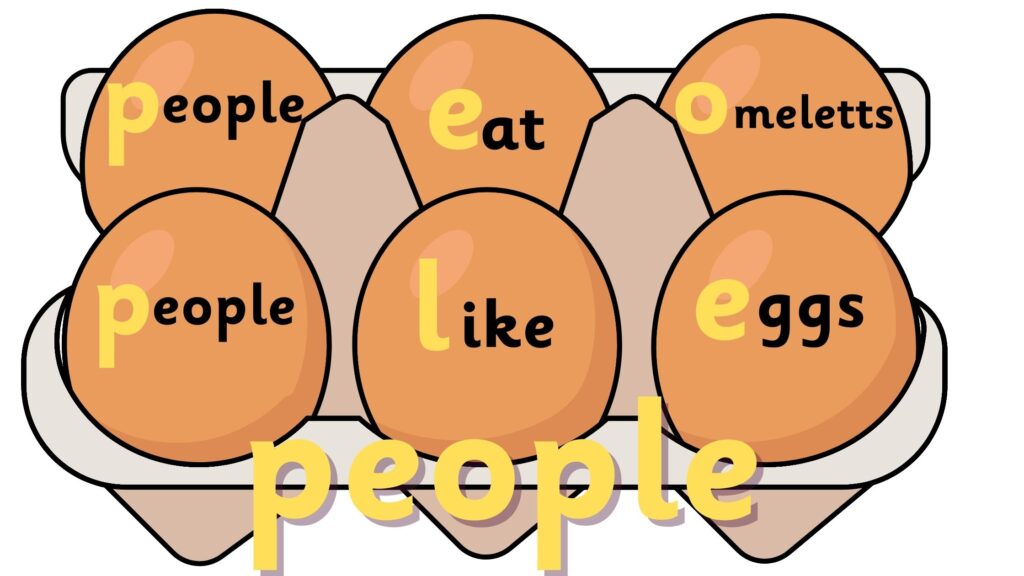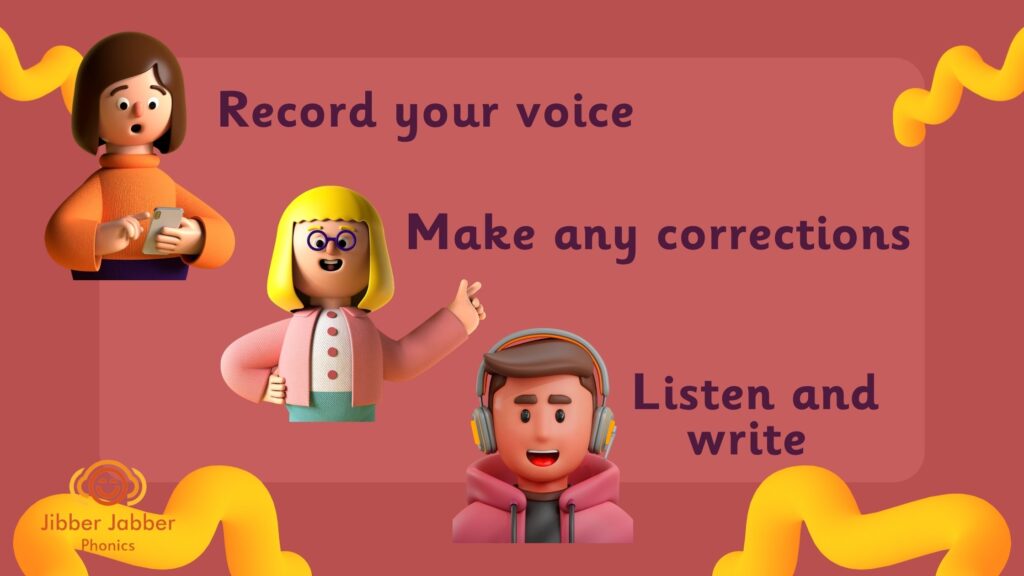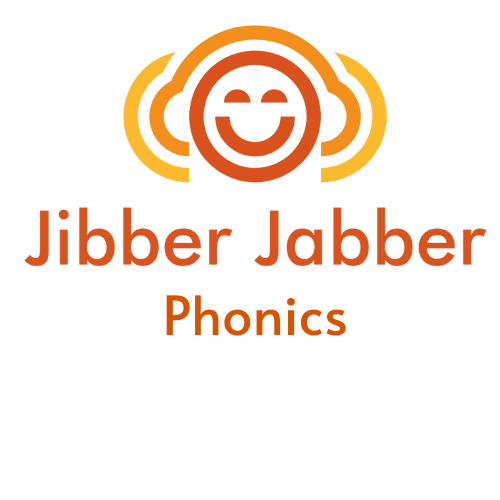Dyslexia Awareness Month is in October. It’s an annual event to raise awareness of dyslexia. I hope we can be aware of the condition throughout the year too!
It is believed that 10% of people are dyslexic, but this condition is often poorly understood. Dyslexia is a learning difficulty that causes problems with reading, writing, and spelling but intelligence is not affected. It is a lifelong condition and with the right support dyslexic people can absolutely shine.
Spelling is likely to be challenging for a dyslexic person. Spelling is challenging for everyone!! When I was at school, I struggled with spelling and reading because I hadn’t been taught how to decode words. Can phonics help with this? Read on to find out.
To read, we can see the word and there are some clues that can help us to say the word.
To spell, we must hear the sounds that the word has and then pull the sounds out of the memory bank to write them down. People with dyslexia may struggle with these skills due to;
- processing information differently
- struggles with recognising the sounds in words,
- lacking in mental strategies to remember the word formation
- overwhelmed by letter patterns
- a mindset that they can’t learn
- bored because it’s not fun!
Beat the struggles with recognising the sounds in words
My skill to identifying each sound in a word or phonemic awareness was poor when I was school age!!
The first step to correct this is to say the words slowly and clearly. Connective speech can cause numerous problems when it comes to spelling. What you say and how you hear it really holds back spelling.
A very famous comedy sketch by ‘The Two Ronnies’ highlights this. Ronnie Barker is shopping and wants handles for forks “fork handles”, the shop assistant, Ronnie Corbett, hears “four candles”.
This is what happens to spelling when we say things quickly and unclear. Slow down a little and pronounce words clearly.

An easy way to remember a difficult spelling.
Not all words are spelt like they sound making them non-decodable. For example, the word ‘people’.
When we say the word, we can hear two syllables. We know that syllables have a vowel sound in them. We can also hear the /p/ sound quite clearly. There is something to start with when spelling this word.
So, with alternative spelling and spelling rules (and there are many of them!) the word ‘people’ could be spelt ‘peepl’ as in sleep, ‘peaple’ as in each, or ‘pyple’ as in happy!!!
Mnemonics can help with this. This is a handy and fun technique to remember how something is spelt. Each letter of the phrase is the next letter of in the word. A popular one for spelling ‘people’ is ‘people eat omelettes, people like eggs.
These difficulties apply to lots of learners not just those with dyslexia.

Why is spelling harder for those with dyslexia?
The skills that those with dyslexia (not all) can find harder are the skills we use for spelling. These skills are;
- Knowing how to apply these sounds. The sound in a word is phonics and these link to how a sound is written (grapheme).
- Memory. To write the sound we need to remember how to form the grapheme.
- Sequencing. To spell something we need to be able to hear the order of the sounds.
- Fluent processing. It maybe that is takes someone with dyslexia a little longer to find the grapheme in their memory bank. Slowing down like this means they may get lost in the word and forget what they are spelling.
- Motor skills. It maybe that they have a problem forming the letter.
These are problems for all that are learning to spell but even more so for those with dyslexia.
How can we help with this?
Multi-sensory learning.
Multi-sensory learning is doing more than once thing at a time. Everybody learns quicker when we see it, say it and do it, at the same time. It’s not necessary to do all three at the same time but certainly at least two things.
You may ask them to be tracing a word (seeing it), producing the sounds (saying it) as they write it and then blending the whole word at the end (doing it). Start with decodable words like ‘sat’, ‘paint’ or ‘assistant’ and only use the sounds they have been taught.
When it comes to letter formation, they can be writing the letter from memory (doing it) and saying the sound at the same time. To expand on this, ask them to do this with their eyes closed.
Pure Sounds.
Introducing new sounds to learners must be demonstrated accurately. Be sure that you are teaching pure sounds. What I mean by a pure sound is without the /uhh/ (schwa) at the end. I often hear sounds produced with uhh at the end and this is confusing.
As readers, we know these three sounds /b/ /i/ /t/ together make the word ‘bit’. By adding the uhh sound to each letter the word becomes /buhh/ /iuhh/ /tuhh/ something like ‘beritter’. Not the word we want!
How to make spelling fun.
If we make things fun, learners will remember how to spell! Learners need to be able to say the word clearly to hear the sounds. To make it fun we can use these great activities for words that can be sounded out.
- talk like a robot. I like to get the children to move like a robot at the same time too.
- record their own voice. Then listen to the playback when they get it right and write the word.
- syllable jumping. Get them up and moving around.

For words that can’t be sounded out we need something else!
Many words have word patterns. This is where a particular group of letters often appear together to form the same sound in a word. Only a few letters change to make a different word.
Word patterns are helpful to those with dyslexia because it eliminates the anxiety when looking at a word in isolation.
Recognising patterns in words makes them less tricky.
For example, /ight/ appears in light, flight, night, fright. There is less anxiety because this pattern is now familiar and learning to spell each word uses less thinking about because they know that /ight/ is a common sound.
Making pictures with these words gives learners a visual reference making it easier to remember.

Another common word pattern is /ould/ as in could, would, should.
There are many word families that you can teach. These include
- /at/ as in cat, bat, sat, pat
- /in/ as in pin, shin, win
- /e/ as in he, she, we, be, me. These tricky words are taught early on in a phonics programme.
These techniques make learning to spell for those with dyslexia less overwhelming and easier to learn. It gives them a sense of control and if they can control something they can use it to spell.
Strengthening Memory with Games.
Memory is essential for learning. To strengthen the memory, playing games is the way to go. Getting kids up and moving in the class makes things fun and when they are having fun they are learning, and this makes it memorable.
Combining the games with spelling rules doubles the productivity of the game. Here are some to try.
Games don’t only have to be in the classroom. Encourage games to be played at home with family too. Things like Pictionary and Taboo are good family fun all round. I have used Jenga too and stuck the sounds or words on some of the blocks so when they push them out of the tower, they can be saying the sound or word at the same time.
Helpful tips and tricks.
Make a mini book with the sounds they struggle with. Mini books are small enough to keep in a pencil case so they can look at it when they need support.
Create their own dictionary. I have made one page for each letter like a traditional dictionary but also added in pages that have alternative vowels and digraphs.
Writing the words on the correct page gives them less words to look through when they are creative writing.
Specific Word Collections
For older learners they could have subject specific word collections. They group together words that often used and difficult to spell. Subject words used in science and maths for example can be written down in one place, to go to quickly, to support their spelling.
If you’re younger learners, I often ask them to write the days of the week on the inside front cover of their writing books so that they are easy to find when they are writing the date to start work.
To learn spelling, we must write it down at some point and these are just some of the ways that can make it easier for those that are struggling with or without dyslexia.
I hope you have liked this blog and found it useful. If you have any comments or questions, please leave them in the section below. There is never a silly question and asking them here will ensure that everyone will get the benefit of the question asked and the answers given.
If you would like some further help and advice, please follow my Facebook page here. I post often at Jibber Jabber Phonics and will always answer your comments. On my website www.jibberjabberphonics.com there are courses where I take you through the stages of teaching phonics to create confident and engaged young learners who achieve amazing results, through fun-filled lessons, without overwhelm and hours of planning.


Some fantastic ideas and tips to help spelling. Have shared with a friend.
Thanks Ruth. Glad you found it helpful and thanks for sharing.